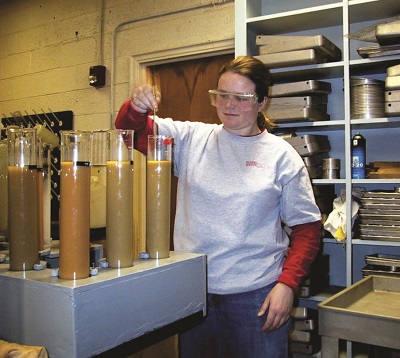SOIL PHYSICS

This is how the sand, silt, and clay percentages are measured in the lab.
Water is necessary for all life on earth. About 70% of rainfall evaporates from plants and soils. The remaining 30% is stored in the soil or runs off.
Soil is made up of the building blocks sand, silt, clay, and organic matter. Between these building blocks is air space. Soil is very different and diverse, depending on where it is located, and therefore, has different ratios of building blocks. These form the soils basic texture. These small particles of sand, silt, and clay lump together to form peds, or aggregates. The shape and size of these peds determine soil structure. Texture and structure impact how water and other liquids, air and roots interact with the soil. Solids also can move, as there are also a lot of hills and depressions that water needs to move through until it gets to the streams or groundwater. This diversity of physical properties is studied by soil physicists.
How much water can a soil store when it doesn’t rain? How fast does water move through the soil into the groundwater or river after a rain? How many greenhouse gases escape from different types of soil? How are the sand, silt, and clay particles built into aggregates, and how does this effect water and air movement? These are some example questions that a soil physicist may ask.
There are many different themes and interactions that soil physicists study, some involving the transfer of energy from one place to another, others study how water moves and interacts with plants, and others study gas emissions, others find out what happens when soil is tilled, and what happens if the soils become to salty to use.
Water Movement

This is a device (Amoozemeter) that measures how fast water flows in the ground
Since water is vitally important for plant growth and drinking, it is important to understand how it moves through the soil matrix (the gigantic maze of aggregates and soil particles). Understanding how water moves can help make decisions about land use and which crops to grow. If a soil has a lot of sand, water moves through it very quickly. This may mean that fertilizers, waste products, or chemicals move through the soil into the groundwater very quickly. If soils have too much clay, the water may not infiltrate into the soils fast enough, and waste products or fertilizers can end up running off into streams and lakes. Some soils can hold onto water well and store it below ground so it is available for plant roots.
Heat Movement and Evaporation
Soil temperature is really important for biological activity and soil formation. Temperatures that are really cold or too hot have limited plant growth and microbial activity, and less chemical action. A dark colored soil absorbs more solar radiation compared to a lighter soil. This changes how plants and microbes can live. How soils conduct heat determines how water evaporates from soil, how much radiation bounces back into the soil atmosphere, how the air is heated above the soil, and how hot the soil is itself. This rate is closely linked with the soil's water content. Hot soils create a lot of microbial decomposition, leading to less organic matter, and they also demand that plants transpire (breathe) faster, which is not a very good thing if the climate is dry, or if there is a drought.
Gas Emissions and Air Movement
As previously discussed, soils are a dynamic system of pores and texture, with spaces inbetween that air and water flow through. Soils have the ability to store greenhouse gases, like carbon dioxide, methane, and nitrous oxide, but they can also release them. Whether soils are a sink (storing greenhouse gases) or a source (releasing greenhouse gases) depends on how the soil is managed. Soil scientists who study gas emission and air movement from soils try to increase the organic matter content in soils by using conservation tillage practices, reducing erosion, and comparing different cropping systems.
Quicksand
Quicksand is an interesting natural phenomenon that happens when soil begins to act more like a liquid than a solid. The "quick" refers to how easily the sand (soil particles) shifts when in this semi-liquid state. Soil is saturated when its pores are almost completely filled with water, essentially forming a soupy mixture of soil particles and water, The saturated soil becomes “quick” when it is suddenly agitated. When the water trapped in the pores can’t escape, the tension that held the sand particles together becomes a pressure that pushes them apart, creating a liquefied soil. Read More!



